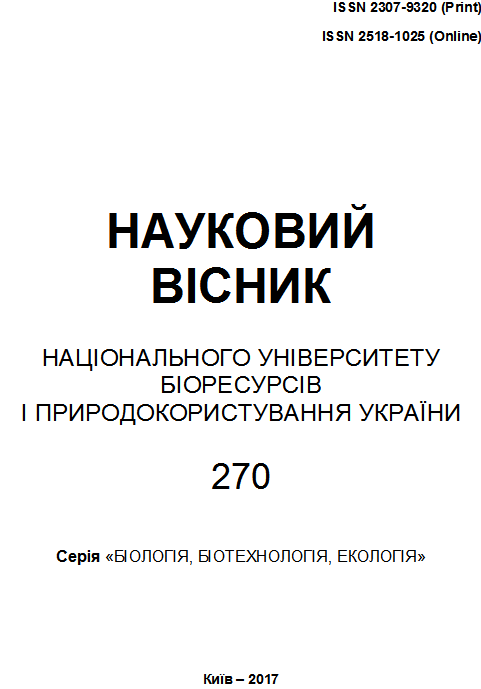EFFECT OF PHOSPHORUS APPLICATION ON THE RATES AND EFFLUX OF CO2 FROM SOIL: 14С LABELING STUDY
Abstract
Global Warming as one of the most important environmental challenge in the XXI century affects crop production, and, thus, is considered as a thread for food security worldwide. Studying the influence of any factors for CO2 efflux is the call of the day. Despite of numerous studies on this topic, the single effect of phosphorus application on CO2 production in soils was poorly understood. Current study aimed to evaluate the influence of increasing P levels with and without C source on CO2 emission rates and total CO2 efflux, and define the source of CO2 by 14C application. P application affects CO2 emission rates significantly at P50 in dormant stage when no C was applied. However, activation of soil microorganisms by C50 led to no P effect within one day after application. Total CO2 efflux 120 h after P50 addition was 1,5 and 2 times greater for no C and C50 treatments respectively, if compared to the mean values for P0 and P10. Nevertheless, experiment with plants should be done to determine the net CO2 emission and take into account the positive effect from P application. The incremental P levels resulted in lower 14CO2 rates for no C treatments, and had the reverse effect at C50 during the first day of experiment. These findings may be further useful for determination the contribution of each component to the global CO2 emission.
References
Alef, K, Nannipieri, P. (1995). Estimation of microbial activities. In Methods in
Applied Soil Microbiology and Biochemistry, Academic Press, 193-270.
Bergkemper, F., Schöler, A., Engel, M., Lang, F., Krüger,J., Schloter M., Schulz, S.
(2016). Phosphorus depletion in forest soils shapes bacterial communities towards
phosphorus recycling systems. Environmental Microbiology, 18(6), 1988–2000.
Bilyera, N. (2017) Effects of P and C inputs on microbial activities in P limiting
bulk and rhizosphere soil Geophysical Research Abstracts Vol. 19, EGU2017-353.
Blagodatsky, S., Smith, P. (2012). Soil physics meets soil biology: Towards
better mechanistic prediction of greenhouse gas emissions from soil. Soil Biology &
Biochemistry, 47, 78-92.
Bleicher, J. Effect of N, organic and mineral acid additions on microbial CO2
emissions in soils of different phosphorus levels. Master Thesis, Georg-AugustUniversity
of Göttingen, 2017. 34.
Bünemann, E.K. (2015). Assessment of gross and net mineralization rates of
soil organic phosphorus: A review. Soil Biology & Biochemistry, 89, 82-98.
Dorodnikov, M., Knorr, K.-H., Kuzyakov, Y., Wilmking, M. (2011). Plantmediated
CH4 transport and contribution of photosynthates to methanogenesis at a
boreal mire: a 14C pulse-labeling study. Biogeosciences, 8, 2365–2375.
Kuzyakov, Y., Blagodatskaya, E.,(2013) Microbial hotspots and hot moments
in soil: Concept & review. Soil Biology & Biochemistry, 83,. 184-199.
Pausch, J., Kuzyakov Y. (2017). Carbon input by roots into the soil:
Quantification of rhizodeposition from root to ecosystem scale. Global Change Biology,
–12.
Senapati, N., Chabbi, A., Giostri, AF., Yeluripati, J. & Smith, P. (2016).
?Modelling nitrous oxide emissions from mown-grass and grain-cropping systems:
Testing and sensitivity analysis of DailyDayCent using high frequency
measurements’. Science of the Total Environment, 572, 955-977.
Smith, P. (2016). ?Soil carbon sequestration and biochar as negative
emission technologies’. Global Change Biology, 22(3), 1315-1324.
WMO greenhouse gas bulletin, 2010. The State of Greenhouse Gases in the
Atmosphere Based on Global Observations through 2009.
Downloads
Published
Issue
Section
License
Relationship between right holders and users shall be governed by the terms of the license Creative Commons Attribution – non-commercial – Distribution On Same Conditions 4.0 international (CC BY-NC-SA 4.0):https://creativecommons.org/licenses/by-nc-sa/4.0/deed.uk
Authors who publish with this journal agree to the following terms:
- Authors retain copyright and grant the journal right of first publication with the work simultaneously licensed under a Creative Commons Attribution License that allows others to share the work with an acknowledgement of the work's authorship and initial publication in this journal.
- Authors are able to enter into separate, additional contractual arrangements for the non-exclusive distribution of the journal's published version of the work (e.g., post it to an institutional repository or publish it in a book), with an acknowledgement of its initial publication in this journal.
- Authors are permitted and encouraged to post their work online (e.g., in institutional repositories or on their website) prior to and during the submission process, as it can lead to productive exchanges, as well as earlier and greater citation of published work (See The Effect of Open Access).

